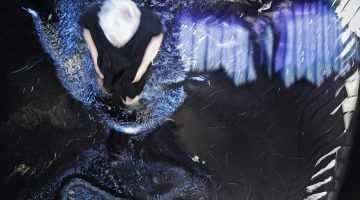As a child I watched Mike Tyson bite off a chunk of Evander Holyfield’s ear live on pay-per-view. Anyone can see it online today—the camera frames the two men’s torsos as Tyson cranes around, clamping onto an inch of cartilage—although, like Rodin’s “Kiss” the action is blocked by the back of a head.
Last September I found myself staring directly into that mouth when I interviewed Tyson in Las Vegas, a crowd of reporters pushing my face a foot away from his. I asked how he sees the relationship between his mind and body: ”This isn’t a bad boy sport, or a tough man sport its a thinking man’s sport.” Although that bite enshrined Tyson-as-brute, I’m interested in boxing and thinking because in talking to eight or so other champion boxers, I recognized an unusual and sparking intelligence. Maybe, for instance, there is some deeper affinity to the similarly hunched postures of Rodin’s “Thinker” and the Hellenistic “Boxer at Rest” currently on loan to the Metropolitan (until July 15).
Structurally, boxing remains much the same since ancient times: barehanded, separate a body from it’s consciousness. Joyce Carol Oates has written that boxing “isn’t a metaphor, it is the thing itself,” which is also true in one sense of sculpture. As physical fact a sculpture exists, and especially in the case of life-size figures, it displaces matter in our bodily perception just as a human being would. The “physical” is present—the thing itself—it is “life” that is conjured through metaphor, the bronze becoming flesh. This inherent disjunction is what I think poet Bill Berkson meant when he once called sculpture “an inherently haunted medium.”
In the Met there is another Hellenistic bronze, an idealized youth, and just as you look up at it high on a plinth, it asks you to look beyond its ravaged surface to a vision of perfection. The pleasures of the “Boxer at Rest” are precisely the opposite, you are supposed to savor the scars and fissures in the bronze, some embedded by the artist but much is just the work of time. “This guy has been through a lot,” not only to get here after being made between the 4th and 2nd century BCE, but the represented figure himself is catching his breath with a broken nose, puffy ears and swollen face.
Thankfully the “Boxer at Rest” is only raised about a foot, putting his seated body on the same level as yours, so you can really encounter it. The artists have tenderly embedded copper into his wounds on his face and ears. This sculpture is very sensitive, and you treasure it for its small attentions: the light engraved star of chest hair like a drawing, the fold of skin just above his belly button. Facing his broad hunched back I want to lean over and kiss it (come to think of it I’ve kissed two friends like this in the past few days—perhaps its something about backs and touch, our own being so outside our vision.) He is resting after having just fought and is looking up to his right, maybe at the crowd, maybe the next challenger, but you can’t help but see him as thinking, even if that thought is “what’s next,” geared toward immediate survival. Those thoughts are much more interesting for a hunk of bronze than whatever is happen for Rodin’s hunk, which is more “thought” than “thinking” by any rate.
Go see it before it goes back to MuseoNazionale Romano – Palazzo Massimo alle Terme, if you can.
For more information visit here.
-Contributed by Jarrett Earnest





